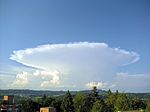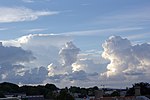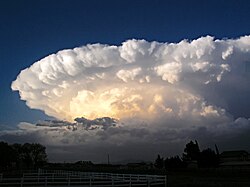Incus
| Incus | |
 Cumulonimbus incus | |
| Svensk benämning | Städ[1] |
|---|---|
| Förkortning | inc |
| Klass | Ytterligare kännetecken samt följemoln |
Incus är en beteckning som ges till ett cumulonimbusmoln som har ett kännetecken i dess övre del i form av ett städ med glättat, trådigt eller strimmigt utseende. Detta städ består av iskristaller och breder ut sig då molnet i sitt uppåtsträvande växande stöter på ett inversionsskikt, vanligen tropopausen.
Incus förekommer endast hos huvudmolnslaget cumulonimbus. "Incus" kommer från latin och betyder "städ".[2]
Det finns teorier om att det är mot detta städ som åskguden Tor slår sin hammare, Mjölner och därmed bildar åska.[3]
Referenser
Noter
Tryckta källor
- Mattsson, Jan O. (2008). Moln: uppkomst, indelning, formvärld. Lund: Studentlitteratur. Libris 10674790. ISBN 978-91-44-04943-4
- World Meteorological Organization (1977). Internationell molnatlas. Instruktioner för tjänstens tekniska bedrivande, 99-0339359-8 ; 5 (3., förkortade utg.). Norrköping: SMHI. sid. 13. Libris 344953. ISBN 99-03-39359-8 (Inb.)
Galleri
Ett cumulonimbus med stort städ
En supercell med stort städ
Molnen i förgrunden är cumulonimbus under utveckling, medan det i bakgrunden syns ett cumulonimbus med städ.
Ett cumulonimbus incus över Afrika sett från rymden.
Media som används på denna webbplats
Författare/Upphovsman: Simenhjort, Licens: CC BY-SA 3.0
Bilde av flere Cumulonimbusskyer som oppstår over Rogaland. Skyene i forkant er ennå ikke ferdig utviklet, mens den i bakgrunnen kan sees med en tydelig ambolt.
Perhaps the most impressive of cloud formations, cumulonimbus (from the Latin for “pile” and “rain cloud”) clouds form due to vigorous convection (rising and overturning) of warm, moist, and unstable air. Surface air is warmed by the Sun-heated ground surface and rises; if sufficient atmospheric moisture is present, water droplets will condense as the air mass encounters cooler air at higher altitudes. The air mass itself also expands and cools as it rises due to decreasing atmospheric pressure, a process known as adiabatic cooling. This type of convection is common in tropical latitudes year-round and during the summer season at higher latitudes.
As water in the rising air mass condenses and changes from a gas to a liquid state, it releases energy to its surroundings, further heating the surrounding air and leading to more convection and rising of the cloud mass to higher altitudes. This leads to the characteristic vertical “towers” associated with cumulonimbus clouds, an excellent example of which is visible in this astronaut photograph. If enough moisture is present to condense and heat the cloud mass through several convective cycles, a tower can rise to altitudes of approximately 10 kilometers at high latitudes and to 20 kilometers in the tropics before encountering a region of the atmosphere known as the tropopause—the boundary between the troposphere and the stratosphere.
The tropopause is characterized by a strong temperature inversion. Beyond the tropopause, the air no longer gets colder as altitude increases. The tropopause halts further upward motion of the cloud mass. The cloud tops flatten and spread into an anvil shape, as illustrated by this astronaut photograph. The photo was taken from a viewpoint that was at an angle from the vertical, rather than looking straight down towards the Earth’s surface. The image, taken while the International Space Station was located over western Africa near the Senegal-Mali border, shows a fully formed anvil cloud with numerous smaller cumulonimbus towers rising near it. The high energy levels of these storm systems typically make them hazardous due to associated heavy precipitation, lightning, high wind speeds and possible tornadoes.During the late afternoon and early evening of April 3, 2004, this supercell thunderstorm dropped 2 inch-diameter hail over Chaparral, N.M. causing widespread damage.








